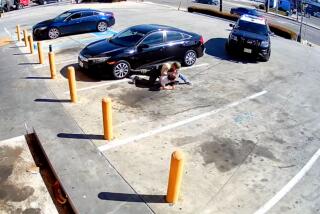Sheriff’s officials probe exchange of photos of bloodied faces
- Share via
After a violent confrontation with a teenage suspect, a Los Angeles County sheriff’s deputy took a photo of the man’s bloodied face and texted it to Sgt. Eric Gonzalez, a friend who worked at Men’s Central Jail.
A few hours later, Gonzalez responded by sending his own photo of a battered suspect: a jail visitor who had been kicked, punched and pepper-sprayed by deputies.
The man in Gonzalez’s photo had two black eyes, one swollen shut, and blood streaming down his face.
FULL COVERAGE: Jails under scrutiny
“Looks like we did a better job,” Gonzalez wrote his colleague. “Where’s my beer big homie.”
“Hahaha,” the deputy responded, according to a text message exchange reviewed by The Times.
Sheriff’s officials are now investigating whether Gonzalez violated the department’s rules by bragging about the man’s injuries. The altercation between the jail visitor and deputies supervised by Gonzalez has also drawn scrutiny from the FBI, which began investigating the incident last year as part of its wide-ranging probe of the county’s troubled jails.
Prosecutors had initially charged the visitor, Gabriel Carrillo, with battery and resisting deputies based on the jailers’ statements. But they later dropped the case. The district attorney’s office concluded earlier this year that the deputies appeared to use necessary force on Carrillo.
In an interview with the Times, Gonzalez said his text message is being misconstrued and was not intended as a boast. He said he sent the photograph to determine whether his colleague recognized the visitor as someone who had recently run from him. The accompanying message, he said, was a joke unrelated to the injuries suffered by either man.
“Is this something to laugh about? Absolutely not,” Gonzalez said.
The probe comes amid intense public scrutiny of the department’s jails and allegations of abuse and other misconduct by custody deputies. A blue-ribbon commission recently concluded that sheriff’s managers fostered a culture in which deputies were permitted to beat and humiliate inmates, cover up misconduct and form aggressive deputy cliques.
Internal department memos obtained by The Times show that top sheriff’s officials raised alarms about deputies meting out “jailhouse justice” against inmates and supervisors conducting shoddy use-of-force investigations. Sheriff Lee Baca recently agreed to sweeping reforms aimed at reducing the violence.
The investigation into Gonzalez’s text exchange is focusing on photographs of two men who are brothers.
Robert Carrillo was injured when he was arrested by two anti-gang deputies in an alleyway in the City of Commerce on Feb. 24, 2011.
Two days later, Gabriel Carrillo went to visit his brother at Men’s Central Jail. In the waiting area, deputies learned he had a cellphone, a violation of jail visiting rules. He was handcuffed and escorted to a nearby break room, which also serves as a booking area when visitors are under arrest.
There are conflicting accounts about what happened next.
Carrillo said several deputies beat him and pepper sprayed him while he was handcuffed. He alleged in a lawsuit that he was kicked and punched until he blacked out, even though he wasn’t resisting.
Deputies said they removed a handcuff from Carrillo’s wrist so he could be fingerprinted, at which point Carrillo swung an elbow at a deputy and began fighting and then tried to flee from the room.
Gonzalez said that, as a supervisor, he stood by and directed the deputies involved in the fight, ordering them to pepper spray and punch Carrillo until he was under control and handcuffed. The sergeant said that during the struggle Carrillo injured some of the deputies and spat a mixture of blood, saliva and pepper spray on one, creating fears the deputy could contract a disease, such as hepatitis or AIDS.
“We’re not trying to hurt him. We’re trying to control him. He’s trying to hurt us,” Gonzalez said.
Gonzalez said he learned immediately after the incident that Carrillo had been at the jail to visit his brother. He said he began making calls to learn more about Robert Carrillo’s arrest and found out that two others who had been with him fled the scene.
Gonzalez said he called the anti-gang deputy who made the arrest. The deputy, an old friend, texted him the photograph of Robert Carrillo. The photo was a close-up shot of him with a bloodied, bruised nose and scratches and scrapes to his face.
Gonzalez said he doesn’t know why his colleague sent him the photo. “Why do guys do stupid things?” he said. “I don’t know.”
Three hours after receiving the photograph, Gonzalez texted back a booking photo of Gabriel Carrillo, which showed his injured face, along with the text message saying “we did a better job.”
Gonzalez insisted that he sent the photograph as part of official law enforcement business to determine whether Gabriel Carrillo was one of the two people who had run away when his brother was arrested. The accompanying message, he said, was intended to tease his friend about how the jail deputies had not allowed their suspect to flee the scene, whereas his friend had let his two suspects get away.
Sheriff’s investigators interviewed Gonzalez last year about the force used against Gabriel Carrillo but did not bring up the texts, Gonzalez said. The sergeant said he voluntarily told them about the messages when the investigators asked whether there was anything they didn’t know about the incident that might embarrass the department.
Gonzalez said he mentioned the texts out of concern that someone might misunderstand their meaning. “I’m a police officer. I think five steps ahead,” he said. “Could it be taken out of context? Absolutely. Would I do it again? Absolutely not.”
Gonzalez has been on leave since January as the internal investigation continues, said sheriff’s spokesman Steve Whitmore.
“If something like this turns out to be true, it could very well lead to a person’s termination,” Whitmore said.
More to Read
Sign up for Essential California
The most important California stories and recommendations in your inbox every morning.
You may occasionally receive promotional content from the Los Angeles Times.












